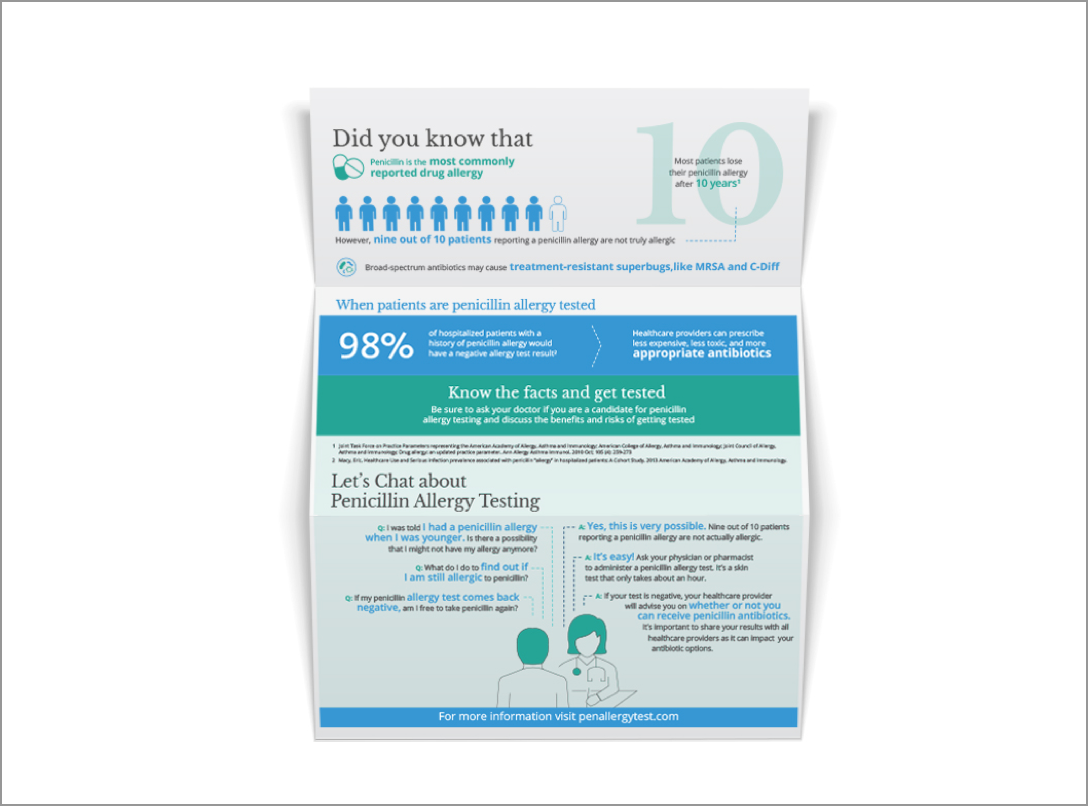National
Penicillin
Allergy Day
“Unverified penicillin allergy is being increasingly recognized as a public health concern."1
Studies have found that an estimated 10% of patients self-report as being penicillin allergic, but only <1% are actually allergic.2
What is National Penicillin Allergy Day?
National Penicillin Allergy Day is an annual celebration to raise awareness around the impact of carrying a penicillin allergy label and how it affects a patient’s healthcare treatment. It focuses on the importance of knowing a patient’s true allergy history while offering tools, activities, and ideas to help create penicillin allergy awareness throughout healthcare offices, facilities, and communities.
Why is correctly identifying those who are not actually allergic to penicillin so important?
- Inaccurate diagnosis of penicillin allergy can adversely impact medical costs for both patients and healthcare systems: research shows that antibiotic costs for patients reporting penicillin allergies are up to 63% higher than for those who do not report being penicillin-allergic.3
- Patients labeled penicillin-allergic may have a threefold increased risk of adverse events (ADE).4 In the hospital setting, history of penicillin allergy translates to about 10% more hospital days,3 30% higher incidence of VRE infections, 23% higher incidence of C difficile infections, and 14% higher incidence of MRSA infections.5
- Correctly identifying those who are not actually allergic can improve antibiotic prescribing and combat the risk of super-bugs by allowing patients access to safer, less toxic antibiotics.4 By some estimates, up to half of all hospitalized patients in the US receive antibiotics and up to half of antimicrobial use may be inappropriate.6 There is a causal relationship between inappropriate antimicrobial use and resistance; changes in antimicrobial use lead to parallel changes in the prevalence of resistance.1
With statistics this compelling, it's important for patients and providers to know the facts about penicillin allergies.
For these reasons, Sept. 28—the date Alexander Fleming discovered penicillin in 1928—has been designated National Penicillin Allergy Day.

How to Get Involved
There are several ways to get involved and help spread the word about National Penicillin Allergy Day!
Toolkit
The NPAD Toolkit offers a variety of educational materials and templates to raise awareness of penicillin allergy within your health system, private practice and community. View and use print products, press materials, and e-tools to support National Penicillin Allergy Day.
Proclamations
A proclamation is an official designation of a day or event that can be used as a tool for gaining public recognition. Proclamations can come from any level of government, including governors and mayors, and carry the full endorsement and support of the government entity that issues the proclamation.
You can request a National Penicillin Allergy Day (September 28) proclamation to be issued in your community.
Social Media
Facebook and Twitter can be excellent platforms to provide awareness to your community on the value and availability of penicillin allergy testing.
We've provided a brief overview of guidelines for posting on social media for National Penicillin Allergy Day that includes tips and some pre-written posts that you can use to tailor your social media efforts.
Web Buttons
Websites can be excellent platforms to provide awareness to your community on the value and availability of penicillin allergy testing. Web buttons provide visitors to your page an easy way to access educational materials and learn more about false penicillin allergies and National Penicillin Allergy Day by hyperlinking directly to nationalpenicillinallergyday.com.
We've provided several button designs to choose from and html code for each that you can easily copy and paste into your webpage.
References
- Macy, Eric. Penicillin Allergy: Optimizing Diagnostic Protocols, Public Health Implications, and Future Research Needs. Current Opinion in Allergy and Clinical Immunology: August 2015 - Volume 15 - Issue 4 - p 308–313
- Is it really a penicillin allergy? Centers for Disease Control and Prevention website. https://www.cdc.gov/antibiotic-use/community/for-hcp/Penicillin-Allergy.html. Updated October 31, 2017. Accessed September 4, 2019.
- Macy, E., & Contreras, R. (2014). Healthcare Use and Serious Infection Prevalence Associated with Penicillin “Allergy” in Hospitalized Patients: A Cohort Study. Journal of Allergy and Clinical Immunology, 133(3), 790-796.
- Owens, R. C., Fraser, G. L., & Stogsdill, P. (2004). Antimicrobial Stewardship Programs as a Means to Optimize Antimicrobial Use. Pharmacotherapy, 24(7), 896-908.
- Blumenthal, Kimberly G., et al. "Addressing Inpatient Beta-Lactam Allergies: A Multihospital Implementation." The Journal of Allergy and Clinical Immunology: In Practice 5.3 (2017): 616-625.
- Dellit, T. H. (2007). Summary of the Infectious Diseases Society of America and the Society for Healthcare Epidemiology of America Guidelines for Developing an Institutional Program to Enhance Antimicrobial Stewardship. Infectious Diseases in Clinical Practice, 15(4), 263-264.




